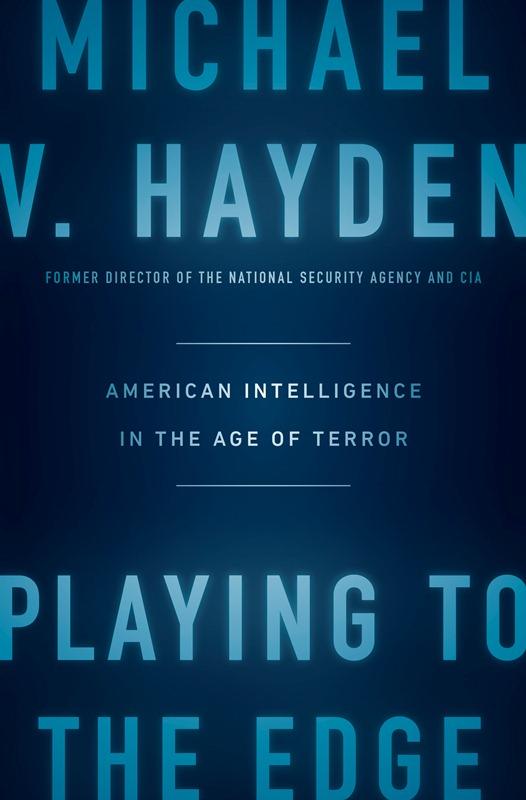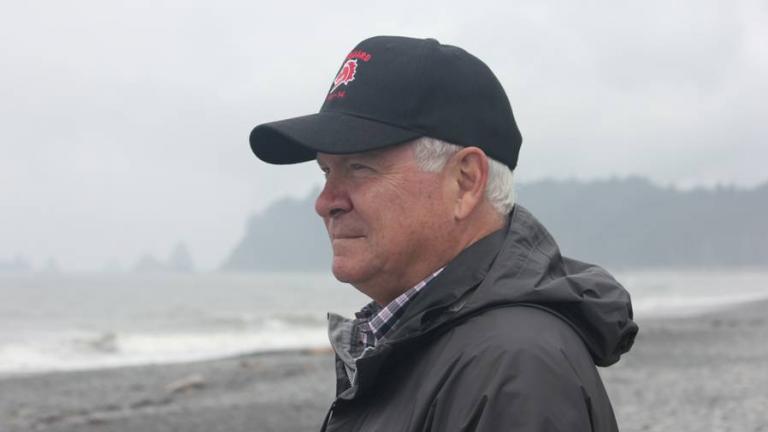He is a retired four-star general who has the distinction of being the only person to head both the NSA and CIA. In his new memoir, “Playing to the Edge: American Intelligence in the Age of Terror,” Michael Hayden candidly reflects on his time at both agencies during the turbulent, post-9/11 war on terror.
He also looks back on a number of gray areas in counterterrorism that sparked debates on how to balance national security and civil liberties—from the use of waterboarding to the data leaks of Chelsea Manning and Edward Snowden.
On how the global community sees the United States
“There’s a lot of tectonics out there shifting around the world, in the Middle East, the rise of China, what’s going on in Russia,” Hayden said. “Do you know the tectonic that the rest of the world is looking at? Us. What are the Americans going to do? More appropriately, what does America think its appropriate role is in the world today?”
“[A friend of mine in Washington says] in the last 20 years, we have gone from a bipolar world to a bipolar super-power, and that’s a very unsettling thing for the rest of the planet.”
On being in Chicago the day Rod Blagojevich was arrested
Hayden recounted a story about meeting with then President-Elect Barack Obama.
“My head of security says, ‘Sir we had to change the location of the meeting,’” Hayden said. “He kind of leaned forward and said, ‘We can’t do it at the Federal Building … They’re arresting the governor in the morning.”
On NSA whistleblower Edward Snowden
In his book, Hayden calls Snowden an “incredibly naïve, hopelessly narcissistic and insufferably self-important defector.”
“This is the single-greatest hemorrhaging of legitimate American secrets in the history of our nation,” Hayden said. “And I get it, he raised a couple of things that raised civil liberties flags here and we’re having grand debates about it. But … the other 98 percent of what he released was how the United States conducts foreign intelligence.”
Read an excerpt of Hayden’s book, below.
“Playing to the Edge: American Intelligence in the Age of Terror”
I had just walked out into the glare of the hot sun of the Australian outback, made even more harsh by the darkened light and digital screens of the windowless operations floor I had just departed. I was in Pine Gap, almost in the middle of nowhere. When you land at the local airport and travel the short service road to the main highway, you are greeted by a road sign. The closest town, Alice Springs, is a little more than ten kilometers to the right. Go left and the next important landmark, the near-mystic and locally sacred Ayers Rock (Uluru), is 450 kilometers away.
As we shielded our eyes from the sun, I turned to my Australian counterpart and asked if he ever wanted to explain to his citizens, and especially to his critics, the quality of the work we had just witnessed inside the facility. Actually, I said something along the lines of, “Wouldn’t you love to be able to show people exactly what we do?” He quickly responded that he would.
Critics, observers, and just average citizens don’t know as much about intelligence as they want or should. A goal of this book is to help address that.
Okay. We can’t go to the outback, but we can go behind the scenes. These pages are my best effort to show to the American people what their intelligence services actually do on their behalf. No Jack Bauers or Jason Bournes here, though. Just hardworking and dedicated Americans whose labor deserves understanding, appreciation, and even occasional criticism. This is a memoir, so I have to tell the story through my eyes, but I hope those about whom I write see it as their story as well.
Of course, there are limits. Classification and such. Frankly, there are too many limits and that hurts the community I served and still love, and the republic it serves. But I have pushed as hard as prudence and the law (and CIA’s Publications Review Board) allow.
Even with stops as an ROTC instructor and some stretches in policy, I can still rightly be described as a career intelligence officer: reading out satellite imagery as a lieutenant at Strategic Air Command headquarters; supporting B-52 operations in Southeast Asia from Guam; head of intelligence at a tactical fighter wing in Korea; an overt intelligence collector as air attaché in Communist Bulgaria; chief of intelligence for US forces in Europe during the Balkan Wars; commander of the air force’s intelligence arm based in Texas.
I enjoyed nearly every minute of those jobs, but this book is less about them than about the last ten years of my government service, the decade I spent at the national level as director of the National Security Agency (DIRNSA), the first principal deputy director of National Intelligence (PDDNI), and director of the Central Intelligence Agency (DCIA).*
There were policy and international issues aplenty in those years (1999–2009), and most of them touched on and were touched by intelligence. Many are recounted here from the perspective I had from those positions. The narrative reflects the always important, but sometimes delicate, relationship between intelligence and the policy makers that it serves. There’s a healthy dose also of the even more delicate relationship with congressional oversight.
There’s a chapter or three on bureaucracy as well. After all, the budgets of the agencies I headed are measured in the billions of dollars, their personnel counts are in the tens of thousands, and their presence is global. Organization, budgets, and personnel decisions matter, not so much in their own right, but as enablers of performance and mission success. Getting the overall structure right has been a pursuit of American intelligence for more than a decade.
Anyone running a large organization will understand how limited the tools of a CEO or a commander or a director really are. He or she can move (or get more) money, move boxes on an organizational chart, change out people, and exhort and inspire. That’s just about the whole toolbox. I’ve always found it difficult to actually finish reading a book on management or leadership, but I’ve nonetheless laid out my experiences here.
Then there’s the spooky stuff—espionage, covert action, and the like. There’s a lot of that even if there’s more to be told that’s not tellable now. A lot of the spooky stuff is about terrorism, but NSA and CIA have global responsibilities, so other topics will appear as well.
The telling is largely chronological, starting with events at NSA and proceeding through the ODNI (Office of the Director of National Intelligence) and CIA. Once engaged on a topic, though, I sometimes play it forward and play it back. The chapter on cyber, for example, comes naturally during my time at NSA, but to tell the tale properly I have to begin in Texas in the 1990s and play it forward through my time at CIA and beyond. There’s some of that with detentions and interrogations too.
Since this is a memoir, its center of gravity is the past, which will perforce drag in issues like renditions, detentions, interrogations, and the badly mislabeled “domestic surveillance” program. But in the writing I was struck by how much my experiences pulled me toward the future, toward things like the cyber domain and its challenges, a domain of conflict and cooperation whose importance seems to grow by the hour.
And, perhaps even more importantly, I was pulled toward the challenge of the long-term relationship between American espionage and the American people in an era of shrinking trust in government and expanding global threats.
I could be accused of grading my own work, but I believe that despite our flaws, we’re actually pretty good at this spy stuff. We need to preserve that capacity. The world is not getting any safer, and espionage remains our first line of defense.
The growing difficulty of that challenge helped prompt the title of this work: Playing to the Edge. The reference is to using all the tools and all the authorities available, much like how a good athlete takes advantage of the entire playing field right up to the sideline larkers and endlines.
In espionage that often proves controversial, and I fear we will not be able to do that in the future without our public’s deeper understanding of what American intelligence is and does, without our doing (at least metaphorically) what I suggested to my Australian counterpart that sunny afternoon. So I committed to tell this story, a story shared by the thousands of folks with whom I have worked.
At bottom, it was a blessing to be part of such a noble enterprise.
From PLAYING TO THE EDGE: American Intelligence in the Age of Terror by Michael V. Hayden. Reprinted by arrangement of Penguin Press, part of the Penguin Random House company. Copyright (c) 2016 by Michael V. Hayden.



